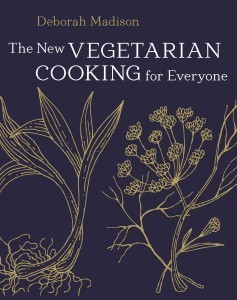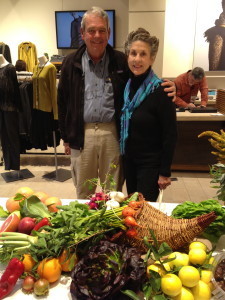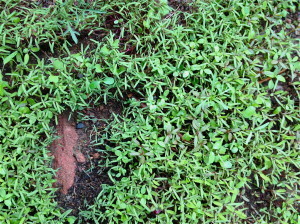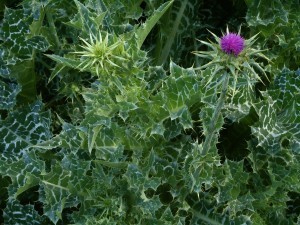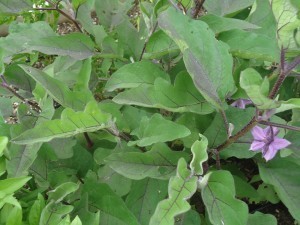Deborah Madison's Blog, page 4
February 27, 2014
What’s New about The New Vegetarian Cooking for Everyone
The NEW Vegetarian Cooking for Everyone is coming out on March 11, and since people are asking how it’s different from the older book, I thought I’d tell you.
For the most part it is the same book you already know. The point wasn’t to write an entirely new book, but to bring its contents up to date. There are 150 new recipes, but there is also a greater emphasis on tempeh (and other fermented soy foods) than tofu, which we now see as being more beneficial than we once thought. There is a designation of those recipes that are vegan and more vegan options as well. Recipes that were especially rich or challenging for other reasons were either eliminated or adapted to reflect today’s tastes. A section on vegetable sautés replaces some of the more complicated stir-fries, and among the breads is now a no-knead recipe with some great variations.
That foods have changed along with our tastes is reflected in this new volume. Ingredients like smoked paprika and smoked salt, shichimi togorashi, rau ram (Vietnamese coriander) and curry leaves are more familiar and available than they once were. We now have coconut oil and a coconut beverage along with almond, rice, hemp and other dairy substitutes. Shishito, fushimi and padron peppers are as familiar to some as jalapeno and serrano peppers once were. Kale was not eaten as salad when VCFE first appeared. Now it is. We may have cooked wheat berries before, but we didn’t cook “farro” until recently, and so it goes. Forbidden rice, frikeh, cracked, pearled and whole farro, unhomogenized dairy have all arrived and today we know about “tartines” as well as sandwiches. Another thing that has changed are the countless authors who are truly expert in a single area, be it bread, curries, Asian vegetables, which means that this volume doesn’t really have to contain everything—for there are many other books to choose from when our expertise in a particular culinary culture grows.
So while there are many changes (plus a new design within and without), it’s also true that many things have remained the same. You’ll find your old friends here and hopefully discover some new ones. (I’ll get that cover up as soon as I figure out how to.)As in the older version, if you’re vegetarian, you can eat everything in this book. If you’re vegan, you can eat from a great many recipes or make the changes you’re accustomed to. And if you are an omnivore, there’s nothing that says these recipes can’t be served with meat or made with meat-based stocks. The choice is entirely yours. As for gluten free, paleo, and the many dietary options that people turn to day, it was not the scope of this work to cover them. My belief is you know who you are, what you like to eat and, quite often, the changes you need to make to make a dish work for you.
Whatever your personal approach, I hope you enjoy The New Vegetarian Cooking for Everyone.


November 29, 2013
The Mighty Gilfeather Rutabaga
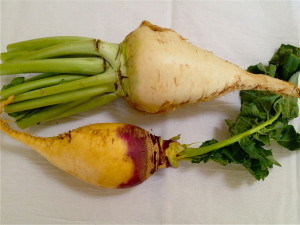
A Gilfeather rutabaga (above) and regular rutabaga (below).
I first heard of this vegetable as the Gilfeather Turnip, but it’s actually a rutabaga. Like other members of the rutabaga group (Brassica napobrassica) it has a long tap root and rootlets issuing forth in two bands that run down the opposite sides of the tuber. Unlike other rutabagas we know it is white skinned and white fleshed whereas the usual rutabaga has a purple band of skin on the outside and inside the color is a delectable creamy yellow. (Also, a turnip is round and doesn’t have those rootlets or taproot.) The flavor of the Gilfeather is rooty sweet with a bit of a peppery twang, much like any rutabaga, but many say, so much better.
When the Slow Food’s Ark of Taste first got going in the USA, this was one of the earliest members to board. Seeds were scarce since the Vermont farmer, John Gilfeather, who grew this vegetable, was so protective of his favorite vegetable that he cut off both the tops and the long roots so that they couldn’t be cultivated. Seed of course, was out of the question, but it’s hard to possess anything in full and a few seeds did get away. Thanks to the Ark of Taste and a few intrepid farmers, you can buy the Gilfeather turnips/rutabaga not exactly everywhere, but in a few select farms. (Find them by going to slowfoodusa/arkoftaste. Look up Gilfeather turnip then go to Local Harvest to find who is growing them. There are a few farmers.)
John McClendon, a farmer in the Phoenix area, is one who grows Gilfeather rutabagas. He placed a hefty specimum in my hand before we each packed up our books and vegetables at the Scottsdale Eileen Fisher store. (We were both showing our wares in this clothing store, but that’s another story.) I was thrilled with the gift and a tucked it carefully into my suitcase to take home.
But the next day I was lucky enough to taste one at FnB Restaurant, also in Scottsdale, grown by Mr. McClendon and prepared by the talented chef Charlene Badman. I can’t give away her secret, but I can say that it was a delectable dish—golden, caramelized, and oddly enough, heart shaped, but not through any contrivances on Charleen’s part. Cut a rutabaga lengthwise and you might just get a big heart. And if you turnout to be a real fan of the Gilfeather rutabaga, this might just be your Valentine’s special. And keep your eyes open for this special heirloom vegetable.


August 13, 2013
What I Learned from the Drought
It’s been a long, hard, hot, dry summer and I’ve tried many times to write about it, but it always gets too moany-groany. So here’s the abbreviated version of what I learned from this summer’s drought, which is actually year 3 of a longer dry period.
When it’s dry, plants die. The world is brown instead of green. It’s easy to become depressed.
When it’s dry, there are no mosquitoes, so it’s a pleasure to sit outdoor in the evening.
During the drought the lilac buds just dried up without opening.
There are very few larkspur, although their blooms are welcome.Usually there are hundreds of them.
Leaves on the fruit trees yellow and fall early.
Those plants that do come up seem feeble. They’re shorter. They don’t feel robust, even when watered.
One carries a lot of water from the kitchen to the garden. Where will a gallon of water be most effective?
Plants don’t thrive under hose-water, even if it is drip and is from a well. It’s just not like rain.
There are no weeds during the drought. No sprouting elms, no native sunflowers, no buckwheat or mountain spinach (orach), amaranths, pigweed, and tumbleweeds. There are however lamb’s quarters and purslane. A lot of each.
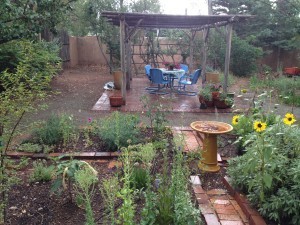
The first monsoon rain drenching the garden.
When it finally does rain, which, miraculously it did, we are ecstatic. Strangers talk with one another with hope and happiness in their voices.
I actually think for the moment that the crisis is over, that our weather world will be normal again.
The world turns greens. Or at least greenish.
There are mosquitoes. Lots of them.
And there are weeds. Hundreds and thousands of them. They were just waiting for that moisture to fall from the sky. I tug at this grassy carpet pulling up elms, sunflowers and amaranths especially, by the handful. If these little green plants were insects or mice, their sheer number would be alarming. Even as plants, go, it’s alarming. The fecundity of annual plants is such that one year when I didn’t weed then went into the far back yard, I was frightened by their sheer density. (The next year is when I started a garden.)
And now that the mosquitoes have driven me inside, I check my e-mail, and there’s notice for a conference —next February, which is six months hence—whose topic is “Drought, Opportunity for Change.” And that’s the same conclusion I’ve come to this summer. Despite the puddles in the driveway, drier times will continue and I’ve come to believe that the most important thing to cultivate is not this plant or that, but a rising mind, one that looks for and finds those opportunities that must be met if we wish to continue gardening for pleasure, growing food, and finding joy in our drying world. The conclusion?
I’m not moving to a rainier clime (at least for now). And I’m going to tackle gardening in hard times with gusto.


March 26, 2013
Little Stars of the Aster Family
One question people ask me when we’re talking about ‘Vegetable Literacy’ is, “What is your favorite plant family?”
“Do you mean to grow or to eat?” I ask.
“To admire for its flowers or for its curvaceous membership?” I wonder.
“Or for its eccentricity, or colorful stories?” I hope.
These botanical families are all quite wonderful and also, quite different, and it’s hard for me to choose a favorite. They’re all favorites.
Some are large, others small. Some common and trustworthy, others strange and eccentric. But the family that is now captivating me most right now is the aster (daisy, or sunflower) family. The word Asteraceae, the name for the family, comes from the Greek word for little star. Think of an asterisk (*), another little star, or an asteroid, a somewhat larger one yet quite little in comparison to our big star, the sun. Jerusalem artichokes are in this family and I once wrote a piece in which I referred to them as “star flowers.” I didn’t know about the word Asteraceae meaning little star, or even what family they were in. They produced sunflowers, but lean and articulated ones, and they struck me somehow as stars, especially those on the ends of eight-food branches, nodding against the sky. How curious that they belonged in the family known by the same name. We know without knowing.
This family intrigues me. Its members are prickly, spiny, hairy, bitter, but with innocent looking daisy-like flowers along with variations on the composite flower theme, such as the tufted purple artichoke and thistle blossoms.
Consider cardoons, artichokes, salsify, burdock, chicories and endives, lettuce grown in too warm a spot. These are plants that in many cases emit a thick, latex like liquid which, if you taste it, and I have, is bitter indeed. You can tear your fingers along the edge of cardoon spine or prick them on an artichoke leaf, and you’ll astonished at all the roots that sprout off a long root called salsify, which give it its other name, “goats beard.” Sometimes my radicchio is almost too bitter to eat. And those strange subterranean creatures, sun chokes, will take over your garden. They might have flowers like little stars, but they’re aggressive in their march towards dominance. Burdock dwells here, too. It was long considered a medicinal plant before it was regarded as a vegetable. Its root grows to such length that harvesting is the challenge. I was once sent a burdock root that was three feet long which said as much about the harvester as about the soil. It was like having a large snake it the kitchen.
The culinary herb in this family is tarragon, which also goes bys the name dragonwort. Or dragon’s mugwort. Artemisia dracunculus. Why dragon? The name dates back to a time when the idea of the Doctrine of Signatures, a system that looks for correlations between a plant and its possible uses. As the roots of tarragon are snaky in appearance, it was thought they were useful for treating snakebites, which were thought of as small dragons.
The Milky Way seems especially well peppered with little stars against the desert night sky, my asters are already up though many months away from making their galaxy of lavender blooms, and there’s enough tarragon to use in an egg salad made with my neighbor’s perfect eggs. Spring is creeping, however slowly, towards its own lush moment.
Egg Salad with Tarragon, Parsley and Chives Makes about 2 cups
I had somehow forgotten about egg salad, but with the tarragon and chives emerging in the garden, eggs becoming more numerous with the lengthening days, and some very good bread in the house, egg salad suddenly came sharply into view. I also add a small, finely diced pickled shallot to egg salad just to insert a little zing into the creamy richness of real farm (or backyard) eggs.
6 farm eggs (likely to be on the small to medium size)
1 tablespoon minced tarragon leaves
1 tablespoon finely snipped chives
1 tablespoon minced parsley or lovage
3 tablespoons mayonnaise
Sea salt and feshly ground pepper
1 small shallot, finely diced and tossed with a little vinegar
chive blossoms, if available
Cover the eggs with cold water in a saucepan, bring them to a boil and boil for 1 minute. Turn off the heat, cover the pan, and let stand for 7 minutes. Pour off the hot water, rinse with cool, then peel and chop the eggs.
Put them in a bowl with the herbs, and mayonnaise. (If you used commercial mayonnaise you might not need much salt.) Taste, add ¼ teaspoon, then taste again. Season with pepper.
If you want the zesty hit of the shallot, toss it, once diced, with just a few drops vinegar and let stand for a few minutes. The color will change right away to a soft pink. If their excess vinegar, drain it off and add the shallots to the mix. Pile the egg salad into a serving bowl and garnish with chive blossoms, if you have some.


March 14, 2013
Connecting the Dots with Vegetable Literacy
‘Vegetable Literacy’ is centered on 12 plant families and how they meet in the kitchen. It’s also a cookbook (some 300 recipe). Mostly it’s about connecting the dots between botany and the garden and the cook. People ask me what inspired this exploration and I have to say that I don’t recall a single moment in which that intention suddenly leaped to the fore. It was more like the idea of botanical families and the relationship between them and the kitchen had been there for a long time. Maybe it’s in my genes—my father was a botanist and gardener and farmer among other things. And even though it didn’t occur to me plant anything until I was in my mid-thirties, something must have rubbed off. And it rubbed off from my botanist brother, Michael, my many farmer friends and the gardeners I have known. Most of all, though, it was starting to garden that made plants and their families come into view with increasing clarity. Once I started to grow vegetables, I saw them in different ways: how much space they need, how large and many their leaves, how similar the blossoms within a family, the possibilities of eating more of them then what we see in the store or even the farmers market—hence the many little pointers about eating the whole plant—and more. The garden reveals the big and sometimes gnarly world that lies behind the pretty vegetable.
I’m the last person to write a book about gardening, and this isn’t a garden book. I’m still a beginning gardener; a fumbler in the garden. Here it is March and I haven’t even planted my peas. Expert or not, it’s amazing what a garden can teach one. It gets you to open your eyes and all of the sudden plants connect to one another, to you, and your cooking like never before. It’s a deep thrill that also be a cheap thrill. You don’t need an acre. Grow a pot of cilantro and use those little green balls before they become dried coriander and you have a really special treat. Or try a larger pot of chard, and an even larger container of potatoes. One caveat is that you do have to be there for your garden and this is the one thing I really had to work to make possible. No traveling in summer. No more teaching or going off here and there. It worked. But ironically, it looks like this summer I’m going to be away from my garden too much to take proper care of it doing what? Walking around the country with ‘Vegetable Literacy’ in tow.
Presenting a book to the world is always a thrill and something of surprise. Here I am hunkered down in my office or out in the garden, and suddenly ‘Vegetable Literacy’ is out there, no longer my near secret activity of the past two years. As my artist husband says about his paintings, he wants them to “grow up and go to college” – that is, get out there in the world, and it’s the same with a book. Although this first foray into the world feels tender and vulnerable; a bit of shock, really, I’m thrilled to have had the chance to write ‘Vegetable Literacy’. I hope it inspires those who read it as it did me while writing it.
And tell me if you wish, what plant families are you drawn to? In the garden or in the kitchen.


February 28, 2013
Greens From the Greenhouse and Greens from the Out-of-Doors
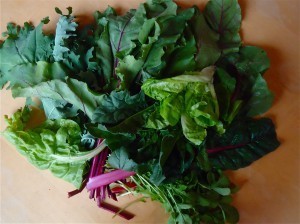
Kale, chard, and other greens from the greenhouse.
A neighbor in my village built an amazing greenhouse last year. Cold air comes up from the bottom and cools it in the summer. In the winter it’s 80 degrees and climbing inside when it’s freezing outside. No wonder he put a bed in there – who wouldn’t want to be warmed by the sun heated room when the night digits plummet to 6 degrees? The problem is that the greenhouse has been so successful that Scott, who built it, has far more greens than he can possibly eat. This means that I, along with other people and two goats, have been the happy recipient of big bags of kale, chard, beet greens, spinach, arugula, and Romaine lettuce. These leaves glisten. They glimmer. They glow. And they are all as soft as flower petals. We enjoy them in soups, salads, braised, even in smoothies. Then I get to go back for more. To have fresh produce in winter is an unexpected joy and I am now seriously bent on putting up a greenhouse of my own.
When it comes to delicacy and cole crops, I have never really put the two together. It’s almost as if they wanted a blast of cold air to toughen up a little. I plunged them in cold water, then dried and refrigerated them thinking that would give them a little more backbone, but it didn’t. Not that there’s anything wrong with these greens just the way they are. They’re surprising, but I’m thrilled to have something from as close as down the road and picked as recently as this morning. This is food that’s alive!
Two weeks ago in Davis, California, I came across their opposites, you might say, while shopping at the farmers market. I bought a pound of mixed greens: kale (four different kinds), savoy cabbage (that January cabbage again), some chard and other brassicas. No protection had been offered these babies. They’d been outside growing through the California rain and chill, growing thick and tough and strong. Unlike the greenhouse leaves, these were so tough and bouncy that for a moment I actually wondered if they’d become tender in the pan? I took them back to my sister-in-law’s house and braised them with garlic and my brother’s olive oil and in fifteen minutes they were tender and succulent and so, so, very good. The greenhouse greens, cooked the same way, were also very good, but it was interesting to see the difference that actual weather makes in strength. The greenhouse greens collapsed to a soft, tender little mound. The field greens did too, but not nearly as much, and you could certainly discern one leaf type from another. If you were from another planet, you might think that you were looking at two entirely different mixes of vegetables. And in a way, you would be.
I gave the field grown greens another try and used them in a salad of cabbage and kale, finely slivered and tossed with the same good olive oil I had been using with the greenhouse greens. They started out tough, but ended up toothy-tender, and because they were strong leaves from the get go, they were good the next day, too. The greenhouse salad was soft, the leaves didn’t need to be slivered at all, it was best eaten as soon as it was tossed, and it wanted a softer oil and less acidic vinegar than those from the out-of-doors. But was one better than the other? They were different, and I’d be happy with either.
If you like kale salads, make your favorite and include some of that crinkly cabbage in it. And don’t shun those greens that are as thick as soft cardboard. They’ll be fine.
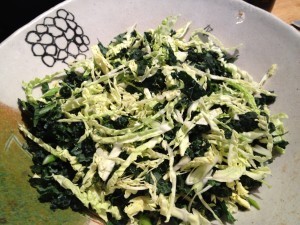
Kale and cabbage salad in a bowl by Robert Brady.


February 8, 2013
Just Vegetables: Radicchio di Chioggia
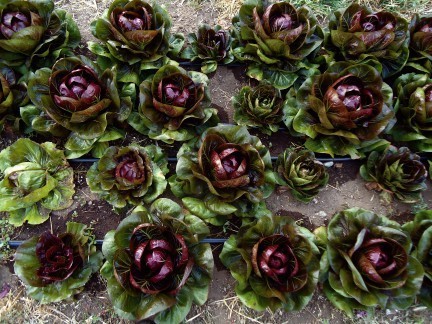
Radicchio in the Garden
At the store we just see the red heart in the center, but in the field we see the other leafy material that is part radicchio, too. The outer leaves, which are green, often lie open, the purple ones next tier in that are also somewhat opened, then finally there’s the tighter purple-red head in the center, looking something like a cabbage, only smaller. Radicchio, however, is not a cabbage, but a chicory, closer kin to lettuce, Jerusalem artichokes, and salsify —all members of the daisy, or aster family, Asteraceae. All of the plants in this family produce flowers that are daisy like in form. During the summer radicchio doesn’t look so interesting in my garden, but the minute the weather turns cool, it starts to turn that seductive dark purple red that makes it irresistible. As dramatic as radicchio is in a salad, I adore it when it’s seared in a skillet and covered with Gorgonzola or another blue cheese. As it’s color fades to brown, its flavor swells and sweetens. I add the cheese once the wedges have been turned then let it soften and ooze into the leaves. Freshly cracked pepper finishes the dish and maybe a little splash of aged red wine vinegar. It’s the winter food I eat often and adore each time I do.
Seared Radicchio with Blue Cheese for 2, or even 1
1 head of radicchio di Chioggia (about the size of a grapefruit)
Olive oil
Slices or small chunks of blue cheese
Sea salt and freshly ground pepper
Cut the radicchio into 6 or 8 wedges, keeping them joined at the base so they don’t fall apart. But even if they do, don’t hesitate to use them.
Coat a cast iron skillet or grill pan with olive oil. When the oil is hot, add the wedges of radicchio and season with them with salt. With the pan being hot but the heat only medium-high, cook until the wedges are browned on the bottom, then turn, adding a little more oil if needed and another few pinches of salt. Lay the cheese over the top, season with freshly ground pepper, and cover the pan. Cook until the leaves are browned all the way through and the cheese has softened, a matter of a few minutes. Remove to a plate and eat as is, or with a dash of vinegar. You can eat this over polenta, too, or with pasta, and it’s delicious paired with roasted winter squash.


January 25, 2013
Just Vegetables: January Cabbage
Just Vegetables: January Cabbage
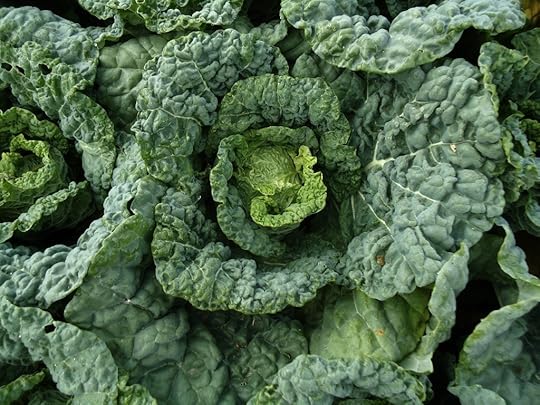 Savoy Cabbage (Brassica oleracea)
Savoy Cabbage (Brassica oleracea)
(Also known as January King Cabbage, Cavalo Verza)
This cabbage is still small, but you can see what a huge mass of leaves are involved in creating a head of cabbage. Savoy cabbages have savoyed leaves, which mean that they’re crinkly and bubbly. And gorgeous. A single leaf looks like a faience plate. As the name January King suggests, this is a royal winter cabbage. Indeed, I find it sweeter than the smooth leafed storage cabbages and it is always my choice whenever possible. The leaves are stunning when blanched then rolled around a filling. When simply cooked and sauced, the leaves have a light and airy feel due to all those crinkles. Some savoy cabbages lean towards the red end of the color chart. Those you find outside of the garden will be stripped of all those outer leaves.
Savoy cabbage is in the Cruciferous family, often called The Cabbage Family.
January Cabbage Salad with Blue Cheese and Mustard Vinaigrette
Serves 4 to 6
The crinkly leaves of January cabbage, or Savoy cabbage, are not as dense as storage cabbages. Thinly sliced into ribbons, they make a fine salad that’s delicate enough. I mix the cabbage with romaine lettuce and red butter lettuce, or whatever I have around, for a mix of textures and colors. Amounts are of course, quite flexible.
4 cups thinly shredded (sliced) Savoy cabbage
2 cups thinly sliced Romaine
2 cups thinly sliced red butter or other lettuce
1 large shallot finely diced
2 tablespoons sherry vinegar or aged red wine vinegar
Sea salt
2 teaspoons smooth mustard
5 to 6 tablespoons olive oil
Blue cheese, thinly sliced or crumbled, ½ cup or more
Combine the sliced greens in a spacious bowl and refrigerate until needed.
Make the dressing. Cover the shallot with the vinegar, add ½ teaspoon salt, and let stand for 10 minutes. Mix in the mustard then whisk in the oil. Taste on a piece of cabbage leaf and adjust, adding more of anything that’s needed.
When ready to serve, pour the dressing over the greens and toss well with your hands. Add the blue cheese and toss once more so that it’s mixed in with the greens. If the rest of your meal has been light, or if this is your meal, add some roasted walnuts as well.


January 17, 2013
The Friendly Breakfast Bap
Deborah Madison's Blog
- Deborah Madison's profile
- 163 followers


